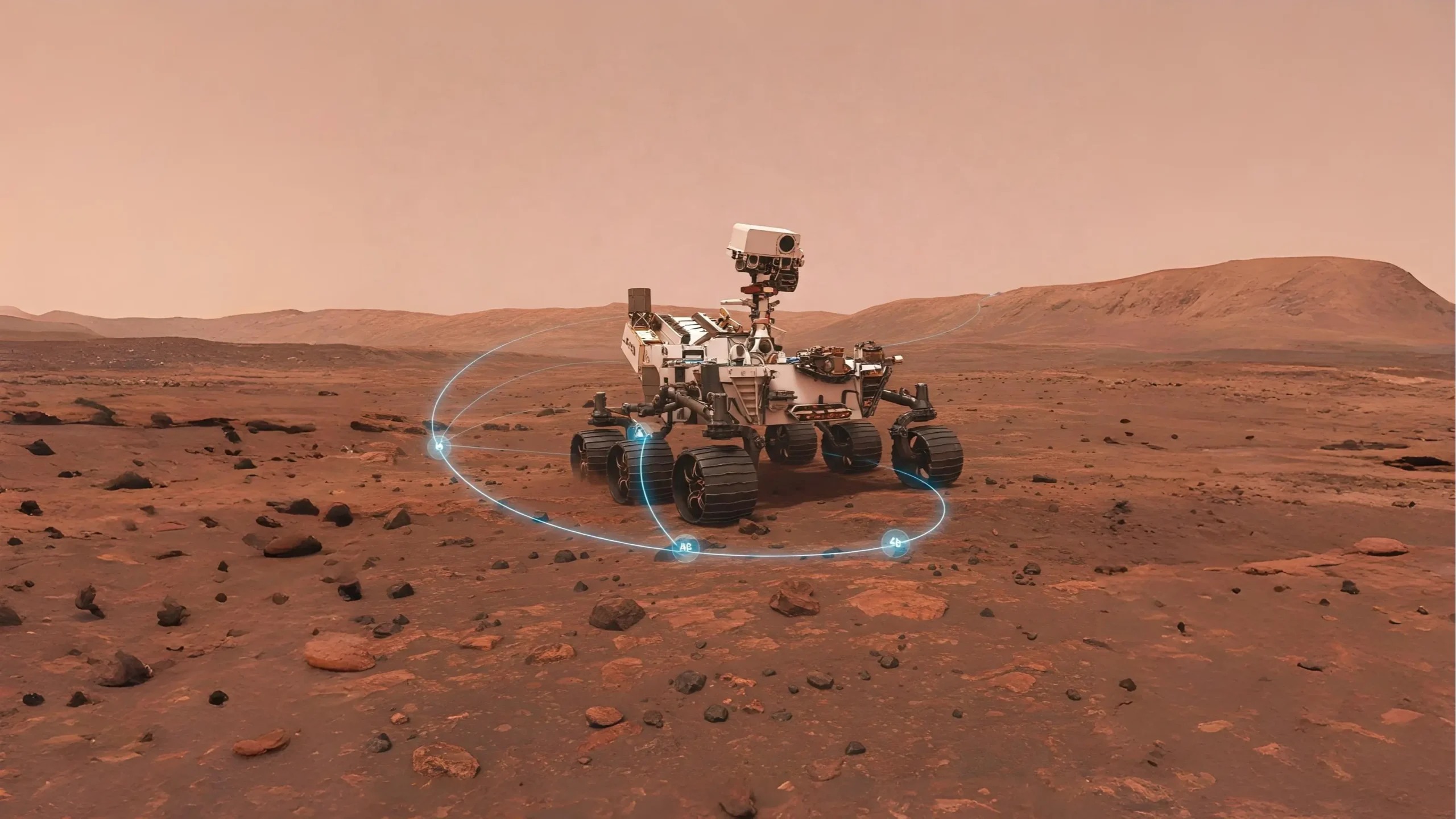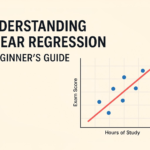Physical Address
304 North Cardinal St.
Dorchester Center, MA 02124

Discover how AI in space exploration transforms mission autonomy, data analysis, and cosmic discovery—revolutionizing humanity's journey to the stars.
AI in space exploration is transforming how we navigate the cosmos, analyze vast datasets, and design autonomous missions that push the boundaries of human knowledge. When we look up at the night sky, we’re gazing at the ultimate frontier—a vast expanse that has captivated humanity for thousands of years. But today, our exploration of space looks dramatically different than it did just decades ago. AI in space exploration has become the game-changing technology that’s revolutionizing how we study, navigate, and understand the universe around us.
From Mars rovers making split-second decisions without human input to sophisticated algorithms sifting through astronomical data to discover exoplanets, artificial intelligence has become as essential to modern space missions as the rockets themselves. These intelligent systems are helping us overcome the fundamental challenges of space exploration: extreme distances, communication delays, harsh environments, and the sheer complexity of the cosmos.
In this comprehensive guide, we’ll journey through the fascinating intersection of artificial intelligence and space exploration, examining how this partnership is transforming our understanding of the universe and opening new possibilities for human advancement beyond Earth.
Table of Contents
ToggleThe relationship between AI and space exploration isn’t entirely new. Early forms of automated systems have been assisting space missions since the 1960s, but what we’re witnessing today represents a quantum leap in capabilities.
NASA’s early missions relied on basic computer programs with limited decision-making abilities. Today’s space systems leverage sophisticated machine learning algorithms, neural networks, and advanced pattern recognition capabilities that can process terabytes of data and make complex decisions autonomously.
This evolution mirrors the broader advancements in AI technology. As computing power increased and algorithms became more sophisticated, the potential applications in space exploration expanded dramatically. The result is a new era where AI doesn’t just assist human controllers—it often takes the lead.
One of the most significant applications of AI in space exploration involves autonomous navigation. Traditional space missions require constant communication with Earth-based control centers, but this approach becomes increasingly problematic as spacecraft venture deeper into space.
The tyranny of distance creates unavoidable communication delays. For example, radio signals take between 4 to 24 minutes to travel between Earth and Mars, depending on the planets’ relative positions. This delay makes real-time control of spacecraft and rovers impossible during critical maneuvers.
AI navigation systems solve this problem by enabling spacecraft to make decisions independently. These systems can:
NASA’s Perseverance rover exemplifies this capability with its autonomous navigation system. Unlike earlier rovers that required explicit instructions for each movement, Perseverance can analyze the Martian terrain, identify obstacles, and plot its own path to designated targets. This autonomy has dramatically increased the rover’s efficiency, allowing it to cover more ground and conduct more science operations than its predecessors.
The volume of data generated by modern space missions and observatories is staggering. NASA’s missions alone generate terabytes of information daily—far more than human scientists could hope to analyze manually.
AI in space exploration has transformed this potential obstacle into an opportunity. Machine learning algorithms excel at finding patterns in massive datasets, making them ideal tools for astronomical research. These systems can:
Perhaps the most celebrated example is NASA’s Kepler mission, which used AI algorithms to help identify thousands of exoplanets. The machine learning system analyzed tiny variations in star brightness that indicated planets passing in front of their host stars—a task that would have taken human astronomers decades to complete manually.
As one NASA data scientist explained: “We’re finding signals that are so subtle, so complex, and buried in so much noise that it would be nearly impossible without advanced AI techniques. It’s like trying to hear a whisper in a hurricane.”
The space around Earth has become increasingly crowded. After decades of launches, there are now over 34,000 pieces of trackable debris orbiting our planet, along with millions of smaller fragments too tiny to monitor consistently. At orbital velocities, even a paint chip can cause serious damage to spacecraft.
AI in space exploration is proving invaluable for managing this growing hazard. Machine learning systems can:
SpaceX’s Starlink satellite constellation uses AI-powered collision avoidance systems that operate autonomously, maneuvering satellites when potential collisions are detected without requiring human authorization. This technology has become essential as the number of satellites in low Earth orbit continues to grow.
The European Space Agency has also deployed AI systems to improve debris tracking, reducing the number of false alarms and unnecessary avoidance maneuvers—each of which consumes precious fuel and shortens a satellite’s operational lifespan.
Perhaps the most visible application of AI in space exploration is in robotic planetary missions. The harsh environments of other worlds, combined with communication delays, make autonomous operation essential for effective exploration.
NASA’s Perseverance rover represents the cutting edge of this technology. Its autonomous features include:
These capabilities dramatically increase the scientific return of missions by maximizing the rover’s productive time. When a rover can make its own decisions about what to study, it can accomplish significantly more during its operational lifetime.
AI transforms spacecraft navigation by enabling vehicles to operate independently of Earth-based control. Traditional navigation relies on commands sent from mission control, creating inevitable delays as signals travel through space. For missions to distant planets or beyond our solar system, these delays make real-time control impossible.
AI navigation systems overcome this limitation through several mechanisms:
The European Space Agency’s Rosetta mission demonstrated these capabilities when it successfully navigated to and around comet 67P/Churyumov-Gerasimenko—a feat that would have been extraordinarily difficult using traditional navigation methods alone.
As one JPL engineer noted: “The distances and complexities involved in deep space missions make autonomous navigation not just beneficial but essential. AI isn’t just enhancing our capabilities—it’s enabling missions that would otherwise be impossible.”
Astronomy has become as much a data science as an observational discipline. Modern telescopes and space observatories generate petabytes of data, creating what astronomers call the “big data bottleneck”—having far more information than human researchers can analyze.
Machine learning breaks this bottleneck by automating the initial analysis process. These systems excel at:
The results have been remarkable. Machine learning algorithms analyzing data from the Kepler Space Telescope helped discover thousands of exoplanets. Similar techniques applied to radio telescope data have identified previously unknown pulsars and fast radio bursts.
| Traditional Astronomy | AI-Enhanced Astronomy |
|---|---|
| Manual classification of objects | Automated classification of millions of objects |
| Limited ability to detect subtle patterns | Identification of patterns invisible to human analysis |
| Analysis of select datasets | Simultaneous analysis of multiple data sources |
| Days or weeks to process new observations | Real-time processing and analysis |
| Focus on expected phenomena | Equal attention to anomalies and expected results |
This marriage of astronomy and AI has democratized discovery, allowing smaller research teams to make significant contributions by leveraging machine learning to analyze publicly available datasets.
Space debris represents one of the most significant challenges to continued space operations. With thousands of satellites and millions of debris fragments in orbit, predicting and preventing collisions has become critical.
AI in space exploration is transforming debris management in several ways:
A notable example is the Space Fence system, which uses advanced radar coupled with machine learning algorithms to track objects as small as 2 cm in diameter—dramatically improving our awareness of the orbital environment.
Perseverance represents the culmination of decades of rover development, with AI capabilities far exceeding any previous planetary explorer. The rover’s artificial intelligence systems serve multiple functions:
These autonomous capabilities dramatically increase the rover’s scientific productivity. Instead of waiting hours or days for instructions from Earth, Perseverance can continue working independently, making real-time decisions that maximize its effectiveness as a scientific platform.
As one NASA engineer put it: “Each Mars day is precious. Autonomy means we can pack more science into every sol on Mars.”
As AI takes on increasingly autonomous roles in space exploration, several ethical considerations have emerged:
These questions become particularly significant when considering potential future scenarios like autonomous exploration of the outer solar system or interstellar space, where communication delays could stretch to hours, days, or even years.
Resource management represents one of the most critical challenges in space exploration. Whether managing a rover’s limited battery life or sustaining a crewed mission to Mars, optimizing limited resources can mean the difference between success and failure.
AI in space exploration excels at resource optimization through:
The International Space Station already employs AI systems to manage power distribution across its massive solar array. Similar systems on Mars rovers help extend their operational lifespans by carefully managing battery usage and recharging cycles.
For future long-duration missions, like a crewed journey to Mars, these capabilities will become even more crucial. AI-driven systems could manage everything from life support to radiation exposure, ensuring crew safety while maximizing mission objectives.
The search for worlds beyond our solar system and potential signs of extraterrestrial life represents one of the most exciting applications of AI in space exploration. These searches involve analyzing vast, complex datasets for extremely subtle signals—perfect tasks for machine learning.
For exoplanet discovery, AI contributes through:
The search for extraterrestrial life benefits from AI through:
NASA’s Kepler mission used machine learning to help identify thousands of exoplanet candidates, many of which have been confirmed through follow-up observations. Looking forward, the James Webb Space Telescope is generating massive datasets that AI systems are helping to analyze for signs of potentially habitable worlds.
As one astrobiologist noted: “We’re looking for needles in a cosmic haystack. AI gives us the ability to search through billions of data points to find the subtle patterns that might indicate we’re not alone.”
Space exploration has traditionally been extraordinarily expensive, with missions often costing billions of dollars. AI is changing this equation by reducing costs across multiple dimensions:
A study by NASA estimated that the autonomous navigation capabilities on Mars rovers reduced operational costs by approximately 30% compared to previous generations of rovers requiring more extensive Earth-based control.
For commercial space companies like SpaceX, AI-driven technologies have enabled innovations such as reusable rockets—a development that has dramatically reduced launch costs from approximately $85 million to $15 million per launch.
Modern satellites increasingly rely on onboard AI for autonomous operations, particularly in scenarios where communication with Earth is limited or impossible. These AI systems enable:
Planet Labs, a company operating over 200 Earth observation satellites, uses AI for automated image capture decisions. Their satellites can identify when they’re passing over areas of interest and adjust their imaging parameters accordingly. When cloud cover is detected, they can autonomously reschedule imaging for a future pass, maximizing the value of each orbit.
Similarly, weather satellites use onboard AI to identify developing severe weather and automatically increase their observation frequency over affected areas—critical capabilities when monitoring rapidly evolving events like hurricanes or severe thunderstorms.
The intersection of AI and space exploration continues to evolve rapidly. Several emerging trends point to transformative developments in the coming decade:
NASA’s Lunar Gateway, a planned space station orbiting the Moon, will incorporate advanced AI systems for autonomous operations during periods when no humans are aboard. This will serve as a testing ground for technologies that could eventually support human missions to Mars and beyond.
As we integrate AI more deeply into space exploration, important questions arise about the appropriate balance between autonomy and human control.
For missions within our solar system, communication delays make some degree of autonomy essential. But as AI capabilities grow, we must consider how much independent decision-making authority these systems should have, particularly for missions that might impact other worlds.
Questions about planetary protection—preventing biological contamination of potentially habitable worlds—become more complex when AI systems might make independent decisions about landing sites or sample collection. Similarly, as multiple nations and private companies deploy AI-enhanced spacecraft, we need clear frameworks for responsibility and coordination.
The space community has begun addressing these questions through organizations like the International Astronautical Federation’s Committee on Space Security and the United Nations Office for Outer Space Affairs. Their work will help establish norms and guidelines for the responsible deployment of AI in space.
AI in space exploration represents one of the most promising technological partnerships of our era. By combining the pattern-recognition capabilities and tireless operation of artificial intelligence with humanity’s innate curiosity about the cosmos, we’re creating new possibilities for discovery and understanding.
From Mars rovers charting their own paths across alien terrain to algorithms sifting through terabytes of telescope data to find distant worlds, AI is transforming every aspect of how we explore and understand the universe. These technologies aren’t just making space exploration more efficient—they’re enabling missions that would otherwise be impossible.
As we look to the future, the integration of AI and space technology will only deepen. Autonomous probes may venture beyond our solar system, swarms of small AI-driven spacecraft might explore distant moons in detail, and AI systems could help establish and maintain human outposts on the Moon and Mars.
The journey outward to the stars has always pushed the boundaries of human ingenuity. With AI as our partner in this great adventure, we’re better equipped than ever to explore the final frontier and uncover the mysteries that lie beyond our home planet.
These advancements not only enhance the efficiency of space exploration but also facilitate missions that would otherwise remain unattainable. Moving forward, the fusion of AI with space technology will further intensify. Prospects include autonomous probes venturing beyond our solar system, fleets of small AI-driven spacecraft meticulously investigating remote moons, and AI systems contributing to the establishment and operation of human settlements on the Moon and Mars. Throughout history, the pursuit of interstellar exploration has stretched the limits of human creativity. With AI as our collaborator on this grand journey, we are better prepared than ever to venture into the cosmos and unveil the enigmas that await beyond our terrestrial confines.

Subscribe to our weekly newsletter below and never miss the latest product or an exclusive offer.




